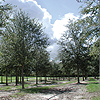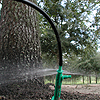Click a question below to view the answer.
The live oak is an amazingly durable tree against bad weather and highly resistant to pests and disease. The Quercus virginiana or Southern Live Oak can measure its lifetime in centuries if properly located and cared for in the landscape.
Standard Live Oaks grow to be large, sprawling, picturesque trees, usually graced with Spanish Moss and strongly reminiscent of the Old South. Also, live oak is one of the broadest spreading of the oaks reaching 40 to 60 feet in height with a 60 to 100 foot spread and usually possessing many sinuously curved trunks and branches. Live oak trees are an impressive sight for any large-scale landscape. For those who don't have an enormous amount of room cultivars have been developed such as the Highrise live oak and others with more upward rather than outward branching offering all the live oak tree benefits without the sprawl. Still, give it plenty of room since the trunk can grow to more than six feet in diameter.
The live oaks we sell are grown in-ground or the technical term "field grown" from about 2-3 feet tall in the nursery until sold to our customers.
B&B or balled and burlap is an old term used when live oak trees were procured directly from the forest. Back then the tree was dug, the root ball was wrapped in burlap then transported and planted in it's new environment. B&B increased mortality in trees and thanks to research and root pruning practices B&B is no longer the desired method for live oak trees. Today field-grown means trees are grown in their native soil in a controlled tree nursery environment. Field grown trees are grown in the ground to a harvestable size, quality trees are root pruned annually, then properly watered and fertilized to develop deep healthy root systems. Trees are then dug or harvested in the winter while dormant, held for 9-12 weeks allowing roots to hardened off (show new root growth), then packaged and readied for transported to the job site. Although field-grown live oak trees are not called balled and burlapped (B&B), field grown live oak trees from a tree nursery are placed in wire baskets and lined with burlap. The tree is then placed in a black plastic sleeve to protect from re-establishing in the ground and to support and protect the roots during transport to their new home.
Field-grown live oak trees are hardened-off or cured after harvesting. Curing roots or hardening-off roots is a process which lasts nine to up to twelve weeks depending on the size of the tree. It simply involves providing the live oak with optimum irrigation during the immediate weeks after harvesting to assure new root growth and healthy and happy trees. This step is crucial to the health and survivability of the Live Oak tree when it’s moved or transplanted to its new home.
Once the live oak tree's roots are hardened-off it is ready to ship (see our Shipping Process page) to the new landscaping site. Seeing new roots on your tree’s rootball means the tree has the best advantage to take off and establish quickly into the landscape. Deep, healthy, new roots growing outside of the burlap is the sign of quality. Our Quality Root System Guarantee reminds you of the care taken to assure the survival of the Live Oak trees we sell in your landscape. Our QRS Guarantee assures that you are planting a quality hardened-off live oak tree.
Live Oaks (Quercus virginiana's) are sometimes called the Southern Live Oak on purpose. They thrive in the warm southern air but can tolerate cold weather and even a little snow, if you live in an area where frost forms in the ground live oaks don’t like their "feet" cold. Here's a list of compatible zones using the American Horticulture Society USDA Hardiness Zone Map:

Where live oak trees will grow:
Southern Pride Tree Farm and our partner growers are located primarily in central, north central and north Florida and we ship trees to Texas, Louisiana, Mississippi, Alabama, Georgia and (of course anywhere in) Florida as well as coastal Virginiana, North Carolina and South Carolina,
Caliper is a nursery standard measurement for the diameter of the trunk of the tree..
Live oak trees are sold by the caliper inch or the diameter of the trunk. Grades and Standards requires the measurement to be taken 12 inches from grade (or from the top of the rootball) 12" up, then around with a diameter measuring tool.
Southern Pride Tree Farm guarantees our customers are buying the best quality hardened-off live oak trees available. Live oak trees are held until new roots develop from the top of the root ball to the bottom and all the way around. Then and only then are the live oak trees showing us they’re happy, healthy and ready to be moved to their new home. We are committed to increasing the awareness and importance of a deep, healthy root system especially for live oak trees.
Grades and Standards were developed by The University of Florida and The Florida Department of Agriculture to provide city and county landscapers with a preferred tree structure and a method of grading the quality difference in trees grown and placed in Florida Landscapes. Grades and Standards also apply to quality trees across the United States. Learn the difference in a Florida Fancy, Florida #1, and others by Clicking here to download and view the University of Florida’s Tree Grades and Standards PDF document.
The organization Roots Plus Growers developed a very good tool called the Tree Planting Cue Card < you can view and download it here. You will need Adobe Acrobat Reader.
Download the University of Florida’s Selecting Quality Trees from the Nursery PDF
Anytime. The inventory we will sell for the year is dug while the trees are dormant in December to as late as mid-February depending on the weather. Trees are then allowed to harden off (allow new roots to be visible from the top of the rootball to the bottom and all the way around) and go through shock (if any) from being dug in the nursery. We make sure Live oak trees are healthy and happy before being shipped so they will establish quickly into your landscape any time of year. In more northern regions of the east coast such as coastal North Carolina and Virginia we recommend the earlier in spring and summer the better so the live oak tree’s roots are established before having to deal with the cold. We also like to recommend protecting roots with a natural mulch such as pine straw especially in the colder regions. Click here to see how we prepare live oak trees for shipping.
We also source other varieties of large field grown trees for our customers such as Magnolias, Red Oaks, Cedars, Crape Myrtles, Bald Cypress, Elms, Ligustrum, Podocarpus, Holly and more.

We're setting higher standards in quality and value more

Why we offer the highest quality live oak trees more

Grades & Standards (Download)
Tree quality at planting has a large impact on longevity more